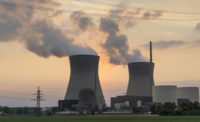Lawsuit: Contractor putting Hanford workers at risk of chemical vapor exposure

The job of the industrial hygiene technicians at the Hanford Site in Richland, Washington, is a matter of life and death. They run around with radiation counters and air samplers, tracking radiation and toxic chemicals that can harm the site’s workers, especially those dealing with dangerous underground tanks full of nuclear wastes in the center of the reservation
To qualify and requalify for their jobs, these technicians are required by federal law to be tested individually by evaluators, with no coaching during the exams.
But for years that hasn’t been happening. Instead, evaluators have been testing these technicians in groups, allowing them to answer as a group.
This and other practices have led many industrial hygiene technicians to be qualified on paper without going through the required rigor in the exams. So says a federal lawsuit filed by a veteran industrial health technician against Washington River Protection Solutions.
Hanford Challenge — a longtime Seattle-based watchdog organization that focuses on Hanford whistleblowers — plans to call for an outside investigation and to put pressure on the U.S. Department of Energy or Congress to take action on the issue.
Hanford has 56 million gallons of highly radioactive fluids, sludges and chunks in 149 leak-prone single-shell tanks and 28 newer and safer double-shell tanks, which are reaching the end of their designed lives. The tanks are the most radioactive and chemically toxic collection of wastes in the Western Hemisphere.
Washington River Protection is in charge of keeping the tanks in good shape and moving wastes from the most leak-prone tanks to the safer double-shell tanks.
For the past several years, tank farm workers have been plagued by sporadic exposures to vapors from the tanks. In 2014, an outside inspection team from the South Carolina-based Savannah River National Laboratory linked the fumes from the tanks and the pipes connecting the tanks to respiratory problems at in the tank farms.
The 2014 Savannah River report recommended Washington River Protection and the Department of Energy resolve the vapor exposure problem with measurable benchmarks, overhaul the industrial hygiene technician programs, improve monitoring equipment and procedures, communicate better inside and outside of Hanford on vapor issues and conduct more research on the matter.
These improvements were supposed to be underway in 2015 and 2016. The number of industrial hygiene technicians at the tank farms had grown from 77 in 2013 to 177 in 2015.
In a written statement, Washington River Protection said: “Washington River Protection Solutions takes employee concerns very seriously. As part of our continuous improvement process, we have addressed chemical vapors-related concerns by implementing robust control measures, comprehensive training practices, and significantly upgrading infrastructure, equipment and monitoring so workers are safe and feel safe.”
Source: https://crosscut.com Crosscut News (Pacific Northwest)
Looking for a reprint of this article?
From high-res PDFs to custom plaques, order your copy today!







